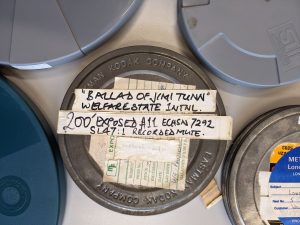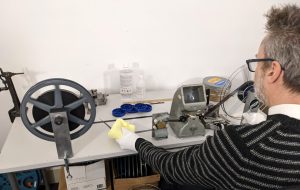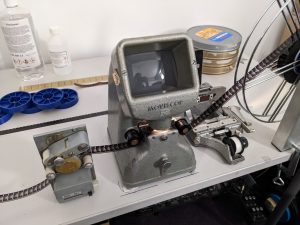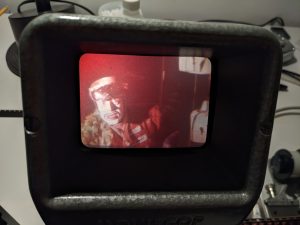Sticky tapes
One of the many challenges we face when digitising audiovisual material from magnetic tape is “sticky-shed syndrome”. Certain types or formulations of tape suffer from this problem that, as the name implies, causes them to literally stick to the components of the playback machine creating a phenomenon known as “stiction”. The friction of the sticky tape against the metal parts causes screeching/squealing noises and slowed/ uneven speed of tape playback. Sometimes the machine will slow down and grind to a halt. If you haven’t encountered this phenomenon before you could be forgiven for thinking it’s a fault on the player. Playback of sticky tapes can result in damage to the tape and in some cases, the playback equipment. The magnetic oxide material sheds from the tape resulting in a distorted signal and dropouts which compromise the quality of the digital transfer. Extreme sticky-shed can cause catastrophic damage to a tape and result in partial or complete loss of the often unique audiovisual material contained on that tape.

Ingredients
Magnetic tape consists of a plastic base layer (substrate), a layer of magnetic oxide or metal particle material (the brown stuff that contains the audiovisual signal) with lubricants and a binder which glues the oxide/metal particles to the base. Some tapes contain an additional back-coat on the base designed to lubricate the motion of the tape through the player and reduce friction.

The problem of sticky-shed results from a breakdown in the binder resulting in hydrolysis i.e. absorption of water. The urethane molecules in the polyurethane binder react with the water, making them migrate to the surface of the tape where they cause the stickiness.
The issue is difficult to identify by visual inspection but suspect tapes should be tested before attempting playback by slowly turning the reel and observing whether the tape unspools naturally or sticks/lingers on the pack. Sometimes the tape surface can exhibit a soft/gummy quality. The problem of sticky tapes has become more apparent over the last 30 years as tape stock ages and patterns of binder breakdown have been identified. Certain brands manufactured entire batches of tape with a faulty binder formulation which almost invariably suffer from sticky-shed. This makes it easier to identify a tape that will have problematic playback before placing it in/on the machine.
Recipe
Thankfully, for most cases of sticky-shed there is a solution – “Baking” the tapes i.e. heating them gently for a period of a few hours. For this purpose, I use a food dehydrator as it is suitable for lower heating temperatures and maintaining them more consistently than a conventional oven. My ultimate goal is to obtain an incubator which operates at the most consistent temperatures over long periods but for now, the dehydrator does the job well. Any apparatus used should not contain strong magnetic fields which can damage the tape’s content. A digital thermometer allows easy and accurate temperature monitoring.

Baking at 54.4°C (130°F) is the sweet spot to temporarily reverse sticky-shed syndrome. The duration required varies for each format but should be at least 2-3 hours with tapes flipped once or twice then allowed to cool for at least the same length of time. Once baked, there is a short window of a few days to digitise before hydrolysis makes the tape sticky again. It’s wise to carry out the process during drier weather conditions as humidity in the air will speed up hydrolysis. A tape can however, be re-baked several times and this is often a requirement for some of the more stubborn formats anyway. As there isn’t 100% consistency of tape behaviour, it can be a case of trial and error – bake for the minimum time, manually test unspooling of tape and carefully attempt playback. If not successful, bake again and so on until the tape plays back correctly.
The main tapes to look out for are:
• Reel to reel audio tapes – Ampex/Quantegy (mid 1970s into the early 1990s) and Scotch/3M. Bake for 3-6 hours.

• U-matic video tapes (1975-1985) by Ampex, AGFA and Sony – those affected often have a wax crayon type smell. The tape reels should be removed from the cassette shell for baking. Bake for 8-16 hours.

• EIAJ ½” open reel video tape – particularly Sony branded V60H, V62 and V30H Helical Scan. If the tape is back coated, it will require baking. These tapes often require long bake times, I have found that manually winding and cleaning with a lint-free cloth after baking can improve playback results. Bake for 8-16 hours, sometimes multiple bakes are required.

• Quad 2” open reel video tape. We don’t currently have any of these in our archives but due to their large size they require extended baking times – up to 24 hours.
Other formats can occasionally suffer from sticky-shed too e.g. Betacam (oxide formulation), VHS, Hi8, even MiniDV.
If you are in doubt as to whether a given tape has sticky-shed syndrome it is much safer to bake it than play it.
Audio compact cassettes are an exception in that the faulty binder was not used in cassette formulations. However, some cassettes can suffer from stickiness due to fatty acids migrating to the surface of the tape. I have baked some notoriously sticky mid-1980s EMI cassettes for 2-4 hours with excellent results.
Slow cassette:
Baked cassette:
The Raw and the Cooked
Just to confuse things, some tapes can also suffer from a different type of Soft Binder Syndrome which can cause squealing on playback. These are often non back-coated tapes and leave less of a deposit on the playback path. It is not recommended to bake these as it can exacerbate the problem. Some success has been achieved by playing back this kind of tape in a cold environment, even placing a playback machine inside a refrigerator. Other tapes display a problem where the back-coat of the tape is turning to powder leaving a non-sticky accumulation of powder on the playback heads. These also shouldn’t be baked but cleaning will be necessary. Finally, never bake an acetate tape. These can be identified when held up to a bright light and visible light can be seen coming through the tape pack.
Despite these exceptions, the most common type of tape degradation you are ever likely to come across is sticky-shed syndrome.
It’s always worth that extra effort to ensure our AV material is preserved in its optimum form.
Happy Baking!
Nigel Bryant
Audiovisual Digitisation Officer










